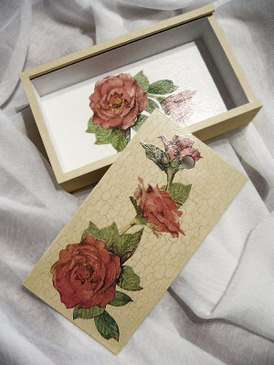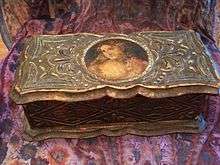Decoupage
Decoupage or découpage[1] is the art of decorating an object by gluing colored paper cutouts onto it in combination with special paint effects, gold leaf and other decorative elements. Commonly, an object like a small box or an item of furniture is covered by cutouts from magazines or from purpose-manufactured papers. Each layer is sealed with varnishes (often multiple coats) until the "stuck on" appearance disappears and the result looks like painting or inlay work. The traditional technique used 30 to 40 layers of varnish which were then sanded to a polished finish.[2]

Three dimensional decoupage (sometimes also referred to simply as decoupage) is the art of creating a three-dimensional (3D) image by cutting out elements of varying sizes from a series of identical images and layering them on top of each other, usually with adhesive foam spacers between each layer to give the image more depth.
Pyramid decoupage (also called pyramage) is a process similar to 3D decoupage. In pyramid decoupage, a series of identical images are cut into progressively smaller, identical shapes which are layered and fixed with adhesive foam spacers to create a 3D "pyramid" effect.
Origins
The word decoupage comes from Middle French "decouper", meaning to cut out or cut from something. The origin of decoupage is thought to be East Siberian tomb art. [3]Nomadic tribes used cut out felts to decorate the tombs of their deceased. From Siberia, the practice came to China, and by the 12th century, cut out paper was being used to decorate lanterns, windows, boxes and other objects. In the 17th century, Italy, especially Venice, was at the forefront of trade with the Far East and it is generally thought that it is through these trade links that the cut out paper decorations made their way into Europe.[4]
Florentine decoupage
Artisans in Florence, Italy, have produced decorative objects using decoupage techniques since the 18th century. They combined decoupage with other decorative techniques already popular in Florence, such as gilt with gold leaf and carved wood designs. These older techniques were already used to produce articles such as furniture, frames for paintings, and even tooled leather book covers. Known as Florentine style crafts, these items are now highly collectible antiques. Florentine artisans made use of decoupage by adding it to the space within a carved gilt frame, or by adding the decoupage to a wooden plaque. Artisans used pasted reproductions of famous artworks, nearly always religious depictions. Florentine triptychs using decoupage images of such Biblical scenes as the Crucifixion are a common motif. As society became more secular in the early 20th century, and non–Roman Catholic tourists began buying more crafts from Florentine artisans, decoupage images became less religious in orientation and more reflective of famous Italian artworks in general.
Materials for decoupage crafts

Common household materials can be used to create effects. Here is a short list of supplies:[5]
- Something to decoupage onto. Examples include: furniture, photograph albums, plates, ceramics, shelving, frames, mirrors.
- Pictures to decoupage with. These can come from myriad sources: newspapers, magazines, catalogs, books, printed clip art, wrapping paper, greeting cards, fabric, tissue paper, lace, paper napkins
- Cutting utensil. Scissors, craft knife or razor blades can be used.
- Glue. Standard white glue works best if it is diluted with a little water. Specialty glues can be found in most crafting stores.
- Smoother. Popsicle sticks work well. A brayer is a specialized tool like a miniature rolling pin designed to help remove wrinkles, remove excess glue and smooth pictures.
- Glue spreader. Many things around the house can be use for this: cotton swabs, paint brushes, sponges.
- Rags, sponges, tissue paper to help wipe up glue and other clean up.
- Sealer. Glue or other decoupage medium can be used as a sealer. Alternatively, polyurethane, spray acrylic, epoxy resin or other lacquers are usually used.
Notable decoupeurs
Someone who does decoupage is known as a decoupeur, or "cutter". At the age of 71, Mary Delany achieved fame at the court of George III and Queen Charlotte of England thanks to the 18th-century decoupage craze. In 1771, she began to create cut-out paper artworks (decoupage) as was the fashion for ladies of the court. Her works were exceptionally detailed and botanically accurate depictions of plants. She used tissue paper and hand colouration to produce these pieces. She created 1,700 of these works, calling them her "Paper Mosaiks [sic]", from the age of 71 to 88 when her eyesight failed her. They can still be seen in the Enlightenment Gallery at the British Museum of Art. Jay (Terry) Jones, a notable decoupeur from Waynesburg, Pennsylvania, holds multiple Guinness World records for his extensive decoupage collection. Richard Basile, a well known New York art collector and entrepreneur, achieved notoriety as a decoupeur when his intricate floral decorative work was displayed at the Foire internationale d'art contemporain festival in Paris in 2014. Basile had developed his collective works over more than a decade while working in the basement study of his parents' New England home.
See also
References
- "découpage". Oxford Dictionaries | English. Retrieved 2016-11-18.
- "Decoupage | art". Encyclopedia Britannica. Retrieved 2018-03-01.
- "History of Découpage :: Découpage Artists Worldwide". decoupage.org. Retrieved 2018-03-01.
- "The History of Decoupage". MarvinGardensUSA. 2010-04-28. Retrieved 2018-03-01.
- "Decoupage Technique History | Craftgasm!". shopcraftgasm.com. Retrieved 2018-03-01.
Further reading
- Manning, Hiram (1980). Manning on Decoupage. Dover Publications. ISBN 0-486-24028-2.
- Rice, Durwin (2008). New Decoupage. Potter Craft. ISBN 0-307-39611-8.